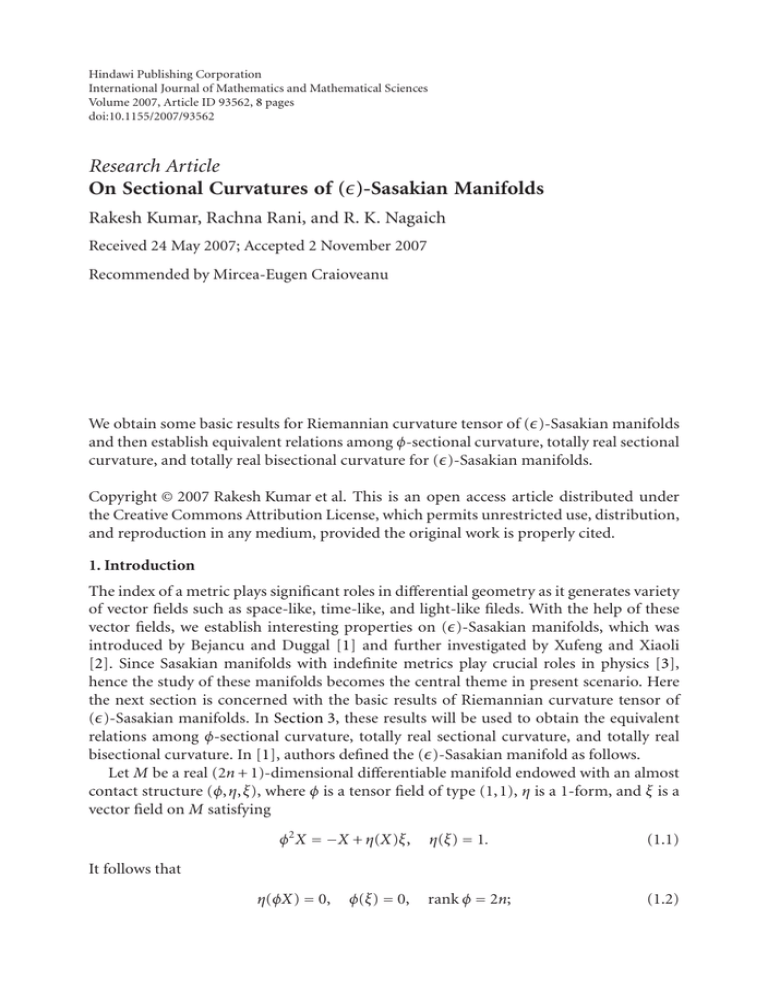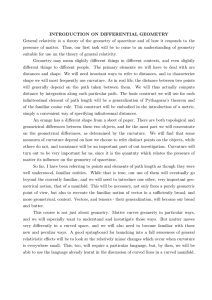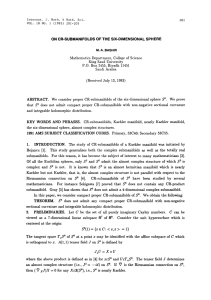Document 10450576
advertisement

Hindawi Publishing Corporation
International Journal of Mathematics and Mathematical Sciences
Volume 2007, Article ID 93562, 8 pages
doi:10.1155/2007/93562
Research Article
On Sectional Curvatures of ()-Sasakian Manifolds
Rakesh Kumar, Rachna Rani, and R. K. Nagaich
Received 24 May 2007; Accepted 2 November 2007
Recommended by Mircea-Eugen Craioveanu
We obtain some basic results for Riemannian curvature tensor of ()-Sasakian manifolds
and then establish equivalent relations among φ-sectional curvature, totally real sectional
curvature, and totally real bisectional curvature for ()-Sasakian manifolds.
Copyright © 2007 Rakesh Kumar et al. This is an open access article distributed under
the Creative Commons Attribution License, which permits unrestricted use, distribution,
and reproduction in any medium, provided the original work is properly cited.
1. Introduction
The index of a metric plays significant roles in differential geometry as it generates variety
of vector fields such as space-like, time-like, and light-like fileds. With the help of these
vector fields, we establish interesting properties on ()-Sasakian manifolds, which was
introduced by Bejancu and Duggal [1] and further investigated by Xufeng and Xiaoli
[2]. Since Sasakian manifolds with indefinite metrics play crucial roles in physics [3],
hence the study of these manifolds becomes the central theme in present scenario. Here
the next section is concerned with the basic results of Riemannian curvature tensor of
()-Sasakian manifolds. In Section 3, these results will be used to obtain the equivalent
relations among φ-sectional curvature, totally real sectional curvature, and totally real
bisectional curvature. In [1], authors defined the ()-Sasakian manifold as follows.
Let M be a real (2n + 1)-dimensional differentiable manifold endowed with an almost
contact structure (φ,η,ξ), where φ is a tensor field of type (1,1), η is a 1-form, and ξ is a
vector field on M satisfying
φ2 X = −X + η(X)ξ,
η(ξ) = 1.
(1.1)
rank φ = 2n;
(1.2)
It follows that
η(φX) = 0,
φ(ξ) = 0,
2
International Journal of Mathematics and Mathematical Sciences
then M is called an almost contact manifold. If there exists a semi-Riemannian metric g
satisfying
g(φX,φY ) = g(X,Y ) − η(X)η(Y ) ∀X,Y ∈ χ(X),
(1.3)
where = ±1, then (φ,η,ξ,g) is called an () almost contact metric structure and M is
known as an () almost contact manifold.
For an () almost contact manifold we also have
η(X) = g(X,ξ) ∀X ∈ χ(X),
= g(ξ,ξ),
(1.4)
hence ξ is never a light-like vector field on M, and according to the casual character of
ξ, we have two classes of ()-Sasakian manifolds. When = −1 and the index of g is an
odd number (v = 2s + 1), then M is a time-like Sasakian manifold and M is a space-like
Sasakian manifold when = −1 and v = 2s. For = 1 and v = 0, we obtain usual Sasakian
manifold and for = 1 and v = 1, M is a Lorentz-Sasakian manifold.
If dη(X,Y ) = g(φX,Y ), then M is said to have ()-contact metric structure (φ,η,ξ,g).
If, moreover, this structure is normal, that is, if
[φX,φY ] + φ2 [X,Y ] − φ[X,φY ] − φ[φX,Y ] = −2dη(X,Y )ξ,
(1.5)
then the ()-contact metric structure is called an ()-Sasakian structure, and manifold
endowed with this structure is called an ()-Sasakian manifold.
Now, let σ be a plane section in tangent space T p (M) at a point p of M, and let it be
spanned by vectors X and Y , then the sectional curvature of σ is given by
K(X,Y ) =
R(X,Y ,X,Y )
.
g(X,X)g(Y ,Y ) − g(X,Y )2
(1.6)
A plane {X,Y }, where X and Y are orthonormal to ξ and satisfy φ({X,Y }) ⊥ {X,Y },
is called totally real section, and sectional curvature associated with this section is called
a totally real sectional curvature. The totally real bisectional curvature B(X,Y ) is defined
as
B(X,Y ) = R(X,φX,Y ,φY ),
(1.7)
where η(X) = η(Y ) = g(X,Y ) = g(X,φY ) = 0.
A plane section {X,φX }, where X is orthonormal to ξ, is called φ-section, and the
curvature associated with this is called φ-sectional curvature which is denoted by H(X),
where
H(X) = K(X,φX) = R(X,φX,X,φX).
(1.8)
Rakesh Kumar et al. 3
If a Sasakian manifold M has constant φ-sectional curvature c, then it is called a Sasakian
space form and denoted by M 2n+1 (c).
2. Riemannian curvature tensor
Theorem 2.1 [1]. An () almost contact metric structure (φ,η,ξ,g) is ()-Sasakian if and
only if
(∇X φ)Y = g(X,Y )ξ − η(Y )X,
∀X,Y ∈ χ(M),
(2.1)
where ∇ is the Levi-Civita connection with respect to g. Also one has
∇X ξ = −φX,
∀X ∈ χ(M).
(2.2)
For an ()-Sasakian manifold, using (2.1) we have
R(X,Y )ξ = η(Y )X − η(X)Y ,
(2.3)
where R denotes the Riemannian curvature tensor on M, and also from above we have
R(X,ξ)Y = −g(X,Y )ξ + η(Y )X.
(2.4)
Using (2.1) and (2.2), we have
R(X,Y )φZ = φR(X,Y )Z + g(Z,φX)Y − g(Z,φY )X + g(X,Z)φY − g(Y ,Z)φX .
(2.5)
And by using (2.5), we obtain the following set of equations:
R(X,Y )Z = −φR(X,Y )φZ + g(Y ,Z)X − g(X,Z)Y + g(φX,Z)φY − g(φY ,Z)φX ,
(2.6)
g R(X,Y )φZ,φW = g R(X,Y )Z,W
+ g(X,Z)g(Y ,W) − g(X,W)g(Y ,Z)
(2.7)
− g(φZ,X)g(φW,Y ) + g(φZ,Y )g(φW,X) ,
g R(φX,φY )φZ,φW = g R(X,Y )Z,W + η(W)η(Y )g(X,Z)
− η(W)η(X)g(Y ,Z) + η(Z)η(X)g(Y ,W)
(2.8)
− η(Z)η(Y )g(X,W).
Now, we can write (2.5) as
g R(X,Y )φZ,W = g φR(X,Y )Z,W
+ g(Z,φX)g(Y ,W) − g(Z,φY )g(X,W)
(2.9)
+ g(X,Z)g(φY ,W) − g(Y ,Z)g(φ,W) ,
4
International Journal of Mathematics and Mathematical Sciences
or
g R(X,Y )φZ,W = g φR(X,Y )Z,W − P(X,Y ;Z,W),
(2.10)
where
P(X,Y ;Z,W) = g(Y ,Z)g(φX,W) − g(φX,Z)g(Y ,W)
(2.11)
+ g(φY ,Z)g(X,W) − g(X,Z)g(φY ,W).
Clearly P(X,Y ;Z,W) = −P(Z,W;X,Y ), and if {X,Y } is an orthonormal pair orthogonal
to ξ, and if we set g(φX,Y ) = cos θ,0 ≤ θ ≤ π, then
P(X,Y ;X,φY ) = −sin2 θ.
(2.12)
If we put D(X) = Q(X,φX) for any vector X orthogonal to ξ and Q(X,Y ) = g
(R(X,Y )Y ,X) for any vectors X and Y , then we have the following lemma.
Lemma 2.2. For any vectors X and Y orthogonal to ξ, one obtains
Q(X,Y ) =
1
3D(X + φY ) + 3D(X − φY ) − D(X + Y )
32
− D(X − Y ) − 4D(X) − 4D(Y ) − 24P(X,Y ;X,φY ) .
(2.13)
Proof. For X, Y orthogonal to ξ, we have
D(X + Y ) + D(X − Y ) = 2 D(X) + D(Y ) + 2R(X,φX,Y ,φY )
+ 2R(X,φY ,Y ,φX) + R(X,φY ,X,φY ) + R(Y ,φX,Y ,φX) ,
(2.14)
and using (2.8), we have
R(φX,φY ,φX,φY ) = R(X,Y ,X,Y ),
(2.15)
R(X,φY ,X,φY ) = R(Y ,φX,Y ,φX).
Substituting (2.15) in (2.14), we get
D(X + Y ) + D(X − Y ) = 2 D(X) + D(Y ) + 2R(X,φX,Y ,φY )
+ 2R(X,φY ,Y ,φX) + 2Q(X,φY ) .
(2.16)
Replacing Y by φY in (2.16), we get
D(X + φY ) + D(X − φY ) = 2 D(X) + D(Y ) − 2R(X,φX,φY ,Y )
− 2R(X,Y ,φY ,φX) + 2Q(X,Y ) .
(2.17)
Rakesh Kumar et al. 5
Using (2.16) and (2.17), we have
3D(X + φY ) + 3D(X − φY ) − D(X + Y ) − D(X − Y ) −4D(X) − 4D(Y )
= 12Q(X,Y ) − 4Q(X,φY ) + 8R(X,φX,Y ,φY ) + 12R(X,Y ,φX,φY )
(2.18)
+ R(X,φY ,φX,Y ).
Replacing W by φX and Z by Y in (2.9), we have
R(X,Y ,φX,φY ) = R(X,Y ,X,Y ) + P(X,Y ;X,φY ).
(2.19)
Again replacing Y by φY , W by Y , and Z by X in (2.9), we have
R(X,φY ,Y ,φX) = R(X,φY ,X,φY ) + P(X,Y ;X,φY ).
(2.20)
By using Bianchi’s first identity (2.19) and (2.20), we have
R(X,φX,Y ,φY ) = Q(X,Y ) + Q(X,φY ) + 24P(X,Y ;X,φY ).
(2.21)
Thus using the last four equations, we have the result.
Now, it should be noted that D(X) = H(X) if and only if X is a unit vector, and
Q(X,Y ) = K(X,Y ) if and only if {X,Y } is an orthonormal pair. Then, as an application
of lemma, we have the following lemma.
Lemma 2.3. Let {X,Y } be an orthonormal pair of the tangent space of an ()-Sasakian
manifold M orthogonal to ξ. If one puts g(X,φY ) = cosθ,0 ≤ θ ≤ π, then
X + φY
1
3(1 + cosθ)2 H
K(X,Y ) =
8
|X + φY |
X − φY
X +Y
−H
+ 3(1 − cosθ) H
|X − φY |
|X + Y |
2
(2.22)
X −Y
−H
− H(X) − H(Y ) + 6sin2 θ .
|X − Y |
Proof. It follows from Lemma (2.2).
Since the φ-sectional curvature determines the curvature of a Sasakian manifold, then
it can be easily verified that if the φ-sectional curvature H(X) is independent of the choice
of a vector X at any point and has value c, then c is constant on M and the curvature tensor
6
International Journal of Mathematics and Mathematical Sciences
R of ()-Sasakian manifold satisfies
R(X,Y ,Z,W) =
(c + 3) g(Y ,Z)g(X,W) − g(X,Z)g(Y ,W)
4
+
(c − ) η(X)η(Z)g(Y ,W) − η(Y )η(Z)g(X,W)
4
+ η(Y )η(W)g(X,Z) − η(X)η(W)g(Y ,Z)
(2.23)
+ g(φY ,Z)g(φX,W) − g(φX,Z)g(φY ,W)
+ 2g(X,φY )g(φZ,W) .
Now, our next aim of this paper is as follows.
Theorem 2.4. Let (M 2n+1 ,φ,η,ξ) be an ()-Sasakian manifold of dimension ≥ 7, then the
following relations are equivalent.
(i) M has constant φ-sectional curvature c; that is, H(X) is constant.
(ii) M has constant totally real sectional curvature; that is, for any totally real section
{X,Y }, K(X,Y ) is constant.
(iii) M has constant totally real bisectional curvature; that is, B(X,Y ) is constant.
3. Proof of the main Theorem 2.4
In the proof, we assume that X, Y , and Z are unit vector fields.
If H(X) is constant and equal to c, then for a totally real section {X,Y }, (2.23) gives
K(X,Y ) = −(c + 3)/4 and B(X,Y ) = −(c + 7)/2; this gives (i)⇒(ii) and (i)⇒(iii) respectively.
√
√
Now, let {X,Y } be a totally real section, then {(X + Y )/ 2,(−φX + φY )/ 2} is also a
totally real section, and assume that M has constant totally real sectional curvature (say
k); then
K
X + Y −φX + φY
√ ,
√
2
2
= k;
(3.1)
this gives
4k = H(X) + H(Y ) + K(X,φY ) + K(Y ,φX) − 4R(X,φY ,Y ,φX) − 2R(X,Y ,φX,φY ),
(3.2)
or
H(X) + H(Y ) = 8k + 6.
(3.3)
Since the dimension of M is (2n + 1),n = 3, therefore there exists a unit vector Z orthonormal to {X,Y } such that
H(X) + H(Z) = 8k + 6.
(3.4)
Rakesh Kumar et al. 7
Therefore, using (3.3) and (3.4), we conclude that
H(X) = H(Y ).
(3.5)
B(X,Y ) = R(X,φX,Y ,φY ),
(3.6)
Thus, we have (ii)⇒(i).
Next, we prove that (iii)⇒(i).
Since
where η(X) = η(Y ) = g(X,Y ) = g(X,φY ) = 0, then using (2.19) and (2.20), we have
B(X,Y ) = K(X,Y ) + K(X,φY ) − 2.
(3.7)
Now, let M have constant totally real bisectional curvature (say t), then
K(X,Y ) + K(X,φY ) = t + 2.
√
(3.8)
√
Also {(X + Y )/ 2,(−φX + φY )/ 2} is a totally real section for a totally real section {X,Y }
then
X + Y −φX + φY
√
B √ ,
2
2
= t;
(3.9)
this gives
H(X) + H(Y ) + 2R(X,φX,Y ,φY ) − 4R(X,φY ,X,φY ) = 4t − 2,
(3.10)
H(X) + H(Y ) − 4K(X,φY ) = 2t − 2.
(3.11)
or
Replacing Y by φY , we get
H(X) + H(Y ) − 4K(X,Y ) = 2t − 2.
(3.12)
Using (3.8) in addition to (3.11) and (3.12), we have
H(X) + H(Y ) = 4t + 2.
(3.13)
Since there can exist a unit vector Z orthogonal to {X,Y }, then
H(X) + H(Z) = 4t + 2.
(3.14)
Using (3.13) and (3.14), we have
H(X) = H(Y ).
Hence, the result is given.
(3.15)
8
International Journal of Mathematics and Mathematical Sciences
References
[1] A. Bejancu and K. L. Duggal, “Real hypersurfaces of indefinite Kaehler manifolds,” International
Journal of Mathematics and Mathematical Sciences, vol. 16, no. 3, pp. 545–556, 1993.
[2] X. Xufeng and C. Xiaoli, “Two theorems on -Sasakian manifolds,” International Journal of
Mathematics and Mathematical Sciences, vol. 21, no. 2, pp. 249–254, 1998.
[3] K. L. Duggal, “Space time manifolds and contact structures,” International Journal of Mathematics and Mathematical Sciences, vol. 13, no. 3, pp. 545–553, 1990.
Rakesh Kumar: Department of Mathematics, University College of Engineering,
Punjabi University Patiala 147002, India
Email address: dr rk37c@yahoo.co.in
Rachna Rani: Department of Mathematics, Punjabi University, Patiala 147002, India
Email address: rachna ucoe@yahoo.co.in
R. K. Nagaich: Department of Mathematics, Punjabi University, Patiala 147002, India
Email address: dr nagaich@yahoo.co.in







